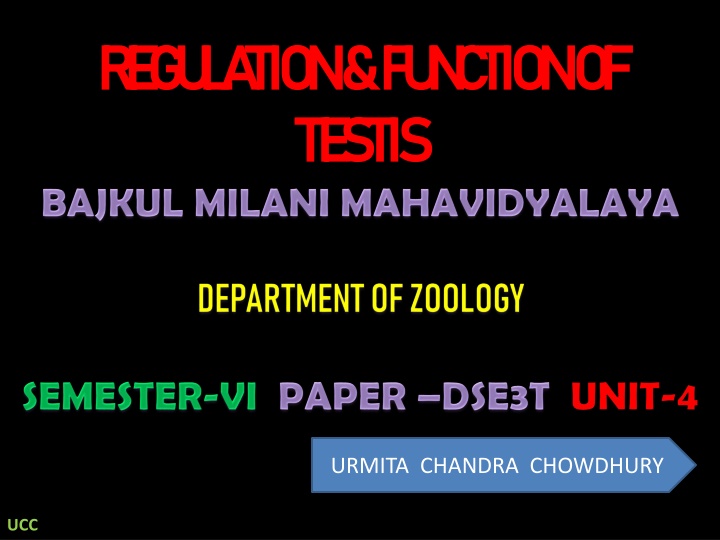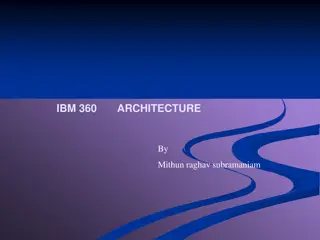
Understanding Male Reproductive System Functions
Explore the regulation and function of the testis in the male reproductive system, including spermatogenesis, role of androgens, and major cells responsible for testicular function. Learn about the crucial compartments within the testes and how they are governed by the hypothalamus and pituitary gland.
Download Presentation

Please find below an Image/Link to download the presentation.
The content on the website is provided AS IS for your information and personal use only. It may not be sold, licensed, or shared on other websites without obtaining consent from the author. If you encounter any issues during the download, it is possible that the publisher has removed the file from their server.
You are allowed to download the files provided on this website for personal or commercial use, subject to the condition that they are used lawfully. All files are the property of their respective owners.
The content on the website is provided AS IS for your information and personal use only. It may not be sold, licensed, or shared on other websites without obtaining consent from the author.
E N D
Presentation Transcript
RE G U L A TION & FU N CTION OF RE G U L A TION & FU N CTION OF TE STIS TE STIS URMITA CHANDRA CHOWDHURY UCC
MAJOR CELLS RESPONSIBLE FOR TESTICULAR FUNCTION GERM CELLS: spermatogonia to spermatozoa SERTOLI CELLS: regulate germ cell development to spermatozoa INTERSTITIAL LEYDIG CELLS: that secrete testosterone, the major androgen UCC
Spermatogenesis and Androgens Spermatogenesis is obligatorily dependent on androgen Early events in spermatogenesis do not require androgens, but full spermatogenesis is obligatorily dependent on androgens (testosterone) Spermatogenesis is dependent on high intratesticular concentrations of testosterone that are normally present in the testis How does androgen act to support and promotes spermatogenesis? UCC
The testes produce the: male gametes (through spermatogenesis) and the male sexual hormones/androgens (through steroidogenesis). Spermatogenesis and steroidogenesis take place in two compartments morphologically and functionally distinguishable from each other. These are the tubular compartment, consisting of the seminiferous tubules (tubuli seminiferi) and the interstitial compartment (interstitium) between the seminiferous tubules. The function of the testis and thereby also the function of its compartments are governed by the hypothalamusand the pituitary gland. UCC
Tubular compartment o Sertoli cell: also known as the nurse or mother cells or sustentacular cells support spermatogenesis. o Their proliferation is triggered by testosterone and FSH secretion. FSHreceptor on its membranes. o Inhibin inhibits its proliferation. UCC
Interstitial Compartment The most important cells of this compartment are the Leydig cells (the source of testicular testosterone). Others are immune cells, blood and lymph vessels, nerves, fibroblasts and loose connective tissue. Leydig cells: respond to luteinizing hormone (LH) with steroid production (primarily testosterone). Leydig cells are unusual in that they rely on de novo synthesis of cholesterol more than other cells (50%). UCC
HYPOTHALAMO PITUITARY TESTICULAR HORMONES 3 tiers of organization: Hypothalamus, Pituitary gland, Testis Hypothalamus: GnRH (gonadotropin-releasing hormone) Pituitary gland: LH (luteinizing hormone), FSH (follicle-stimulating hormone) LH: stimulates Testosteroneproduction by Leydigcells in interstitium FSH: supports spermatogenesisby stimulating Sertolicells in the seminiferous epithelium Testis: Testosterone: Inhibin:secreted by Sertoli cells, suppresses FSH secretion by gonadotropes; Activin: secreted by Sertoli cells, stimulate transcription of FSH B subunit UCC
Functional Organization of the Hypothalamo-Pituitary System The gonadotropins (luteinizing hormone (LH) and folliclestimulating hormone (FSH)) are produced and secreted by the gonadotropic cells of the anterior pituitary. they control steroidogenesis and gametogenesis in the testis. They are regulated by the hypothalamic gonadotropin-releasing hormone (GnRH) UCC
Hormonal control of testicular function At puberty, secretion of gonadotropin-releasing hormone (GnRH) increases Stimulates anterior pituitary to increase secretion of luteinizing hormone (LH) and follicle-stimulating hormone (FSH) LH stimulates Leydig cells to secrete testosterone Testosterone stimulates spermatogenesis, Synthesized from cholesterol in testes Suppresses secretion of LH and GnRH via negative feedback Enzyme 5 alpha-reductase converts testosterone into dihydrotestosterone (DHT) in external genitalia and prostate FSH acts indirectly on spermatogenesis UCC
Contd of hormonal control of testicular function FSH and testosterone act on Sertoli cells to promote spermatogenesis and stimulate secretion of androgen-binding protein (ABP) ABP binds testosterone keeping concentration high for spermatogenesis. Inhibin suppresses the effects of FSH locally in the testes as well as FSH secretion by the pituitary. Activin locally opposes the effects of inhibin. UCC
SUMMARY OF HORMONAL EFFECT ON TESTICULAR FUNCTION UCC
MALE REPRODUCTIVE AXIS 3 tiers of organization: Hypothalamus, Pituitary gland, Testis Hypothalamus: GnRH (gonadotropin-releasing hormone) Pituitary gland: LH (luteinizing hormone), FSH (follicle- stimulating hormone) LH: stimulates Testosteroneproduction by Leydigcells in interstitium FSH: supports spermatogenesisby stimulating Sertolicells in the seminiferous epithelium Inhibin:secreted by Sertoli cells, suppresses FSH secretion by gonadotropes; ? Use of Inhibin B as marker for impaired testicular function Activin: secreted by Sertoli cells, stimulate transcription of FSH B subunit UCC
Developmental Male hormonal testicular function Leydig cell differentiation 1st wave - 7 weeks gestation: stimulated by Human Chorionic Gonadotropinfrom placenta; androgens appear in circulation 2nd wave - 2-3 months after birth: stimulated by gonadotropin production from neonate s pituitary; briefly elevates Testosterone Androgens produced during first 2-6 months of life are thought to hormonally imprint hypothalamus, liver, prostate, phallus & scrotum Leydig cells of infants then regress & testes are dormant until puberty. Puberty Hypothalamus generates pulses of GnRHaround 12th year of life Onset of GnRH pulses typically occurs at night, due in part to gradual decrease in nocturnal melatonin secretion from pineal gland Also influenced by nutritional status of body and growth rate GH & IGF-1 stimulate reproductive function Leptindetermines size of fat stores in body - ? Role in puberty UCC
MALE REPRODUCTIVE AXIS Aging of Hypothalamic/Pituitary Axis Testosterone: levels decline at > 50 years of age LH: basal levels increase in older men; LH pulsatility is blunted Leydig cells: steroidogenic capacity decreases Spermatogenesis: lower fecundity at > 40 years, 50% lower probability of achieving pregnancy w/in 1 year compared to men < 25 years of age. UCC















